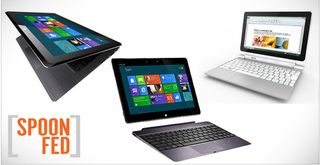Windows 8 TabletBooks: Hybrids Microsoft's Only Shot Against the iPad

If you’re going to completely re-imagine your operating system with a new touch-friendly interface, you had better pair it with hardware that gets people excited about upgrading. And that’s exactly what Microsoft’s partners have done with a wave of new devices hitting shelves this fall. The big theme? Hybrids. Lots and lots of hybrids.
By combining touch screens with physical keyboards, everyone from Acer and ASUS to Samsung and MSI is banking on consumers wanting a tablet and laptop in one device. I'm calling them TabletBooks. And as evidenced by the slew of combos on parade this week at Computex, there’s plenty of variety within this combo category. Some designs let you detach the slate from a dock, while others will sport sliding mechanisms. Then there are Windows 8 Ultrabooks with screens that flip backward so you can give presentations or use them as slates.
We know what you’re thinking: Didn’t convertibles tank last time around? Indeed they did. But there are a few key reasons why things should be different for TabletBooks.
- Windows 8 is optimized for touch. The reasoning is that even those users who prefer a clamshell design will want to touch the screen. Yes, touchpad gestures will mirror a lot of that, but it’s not the same as interacting directly with that game or photo gallery.
- Today’s designs are a lot thinner and lighter than the convertibles of yesteryear. For example, back in 2003 HP’s Compaq Tablet PC TC1100 weighed 4 pounds with its keyboard attached and was 0.8 inches thick. Today’s ASUS’ Taichi Ultrabook-tablet weighs less than 3 pounds and is 0.4 inches thick. And that’s with two screens—one on the front and one on the back.
- People want keyboards. According to a recent NPD Group study, 40 percent of those who were planning to buy a tablet expressed interest in a hardware keyboard, and most of those shoppers said they wanted the keyboard fully integrated. “Consumers want keyboards to use with their tablets,” said Stephen Baker, NPD’s vice president of industry analysis.
But if that’s the case, why does Apple control 68 percent of the tablet market with a slate form factor? Why aren’t most tablet buyers acting on their desire for a keyboard? Part of it is because of the simplicity and portability of the iPad; especially when paired with a Smart Cover, typing is a pretty decent experience on Apple’s tablet. Plus, there’s a ton of sleek after-market keyboards available at affordable prices, such as Logitech’s Ultrathin Keyboard Cover.
“While it is good for PC makers to create convertibles and combos, they do tend to add cost versus buying a keyboard accessory for a tablet—all of those are almost always under $100,” Baker said.
But there’s a much bigger reason many shoppers haven’t acted on their desire for the tablet to have a keyboard out of the box. Android and iOS simply weren’t designed with this kind of input in mind. Windows 8 actually works best with both a keyboard and touch screen. For example, you can start searching for apps, files and anything on the Web right from the Start screen just by typing, then tap the results. There are also dozens of helpful keyboard shortcuts built into the OS, such as Windows logo key + C for activating the Charms menu and Windows + Z for opening the app bar, great when you’re working in clamshell mode.
This new breed of hybrid does involve some trade-offs. The first is price. For example, a convertible such as the Lenovo IdeaPad Yoga will cost about $1,000, which is reasonable for a Core i5 Ultrabook with touch input. But that’s also twice the cost of the iPad. On the plus side, Windows RT tablets should be cheaper than Ultrabooks with touch screens, in the $500-to- $700 range.
Stay in the know with Laptop Mag
Get our in-depth reviews, helpful tips, great deals, and the biggest news stories delivered to your inbox.
That brings us to another potential pain point: confusion surrounding the different versions of Windows. Some hybrid designs will run the full version of Windows 8, which means users will be able to run both desktop apps and touch-friendly Metro apps purchased from the Windows Store. TabletBooks powered by Windows RT will be able to run only Metro apps, though there will be a Metro version of Office.
There are plenty of reasons to be skeptical about Windows 8 TabletBooks taking off, not the least of which is Microsoft’s track record. “Consumers have not seen value in having convertibles in the past,” stressed Baker. “We will have to see if Windows 8 and Win RT change that viewpoint.”
However, Microsoft’s software alone will not change consumers’ minds. It will require the one-two punch of Windows 8 and innovative designs that truly make the most of the OS. The ambitious devices shown at Computex prove that the PC as we know it is dead—and that’s a very good thing.
Editor-in-chief Mark Spoonauer directs LAPTOP’s online and print editorial content and has been covering mobile and wireless technology for over a decade. Each week Mark’s SpoonFed column provides his insights and analysis of the biggest mobile trends and news. You can also follow him on twitter.
